“这个拥抱的温度令我永生难忘。”——珍·古道尔
“当我凝视黑猩猩的眼睛时,看见的是一个正在进行思考与推理的个体回望着我。”珍·古道尔(Jane Goodall)在2017年《国家地理》推出的纪录片《珍》中说道。
这部影片从超过100小时的未公开影像中剪辑而成,生动记录了这位如今享誉全球的灵长类动物学家在20世纪60年代坦桑尼亚冈比国家公园的研究历程。
"Staring into the eyes of a chimpanzee, I saw a thinking, reasoning personality looking back," said Jane Goodall in the 2017 National Geographic documentary Jane. The film, crafted from more than 100 hours of previously unseen footage, captures the now world-renowned primatologist during her work in the 1960s at Gombe Stream National Park in Tanzania.
chimpanzee /ˌtʃɪmpænˈziː/:黑猩猩
这位享有世界声誉的英国动物学家、灵长类专家和动物保护人士于现在正在中国!

11月30日,古道尔在中国科技馆参加根与芽30周年庆典。图片由根与芽北京提供
在她为期一周的行程中,于今年4月份度过90岁生日的古道尔和许多中国热爱环保和动物的青少年一起,庆祝她发起的“根与芽”(Roots & Shoots)项目在中国落地30周年。
The English zoologist and world's foremost expert on chimpanzees is now in China! Goodall, who celebrated her 90th birthday this past April, has made the trip to celebrate the 30th anniversary of her Roots & Shoots program in China. The program was first launched by Goodall in 1991 to engage the young generation in the protection of the environment and the ecosystem, before it was brought to China three years later, in 1994.

11月30日,古道尔在中国科技馆参加根与芽30周年庆典。图片由根与芽北京提供
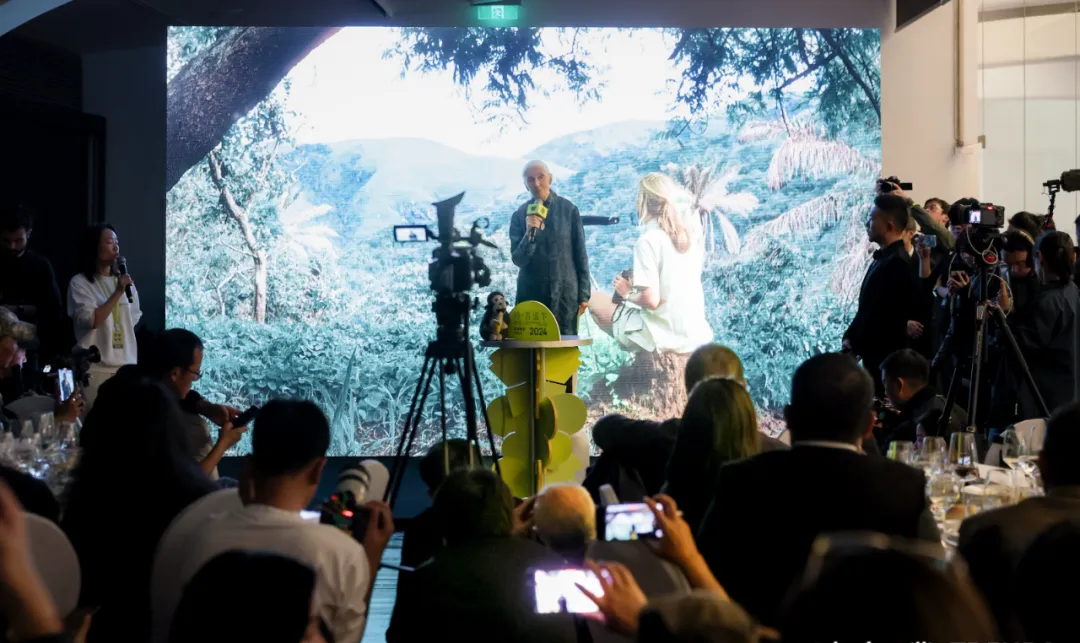
在12月2日的珍·古道尔希望之旅慈善晚宴上,古道尔向来宾讲述自己当年在非洲的故事。图片由根与芽北京提供
上周六中午,古道尔刚刚抵达北京几个小时后,就出现在中国科学技术馆,与来自全国各地的“根与芽”项目成员交流他们的故事。
其中一支获得“成长奖”的团队来自中国东部沿海城市青岛,他们开展的活动包括绘制当地水资源地图以及保护生活在中国黄海海湾的濒危东亚江豚。江豚保护促成了青年学生们与熟悉江豚生活环境的当地渔民的合作。
学生们还为渔民的孩子提供免费课程辅导——这正是古道尔一直提倡的社区型保护的典范。
No more than two hours after Goodall's arrival in Beijing around noon last Saturday, she was in the China Science and Technology Museum collecting stories from young followers from the Roots and Shoots program who had come from all over the country.
One team that won a Persistence Award hails from Qingdao, a coastal city in Shandong province, eastern China. Since their inception under Roots and Shoots, the team — now boasting over a thousand members — has engaged in a wide range of projects, from mapping the region's water resources to protecting the endangered finless porpoise inhabiting the bays of China's Yellow Sea.

12月2日,古道尔在位于北京798的尤伦斯当代艺术中心观展《致敬珍·古道尔博士——驱动力:共情与直觉艺术展》。图片由根与芽北京提供
动物们所经历的痛苦和创伤永远会让古道尔动容。
1966年,古道尔眼睁睁地看着一场毁灭性的脊髓灰质炎(小儿麻痹症)疫情袭击了冈比国家公园的黑猩猩们——这个公园今天因古道尔在这里对野生黑猩猩进行的长期研究而闻名,是全球关注黑猩猩保护和行为研究的重要地点之一Back in 1966, Goodall watched helplessly as a devastating polio epidemic struck the chimpanzees at Tanzania's Gombe Stream National Park, where she had made her world-famous study on what she called "our closest kin".

20世纪60年代,珍·古道尔在坦桑尼亚冈比国家公园,图片由JGI/雨果·范·劳维克提供
一只名为麦格雷戈(Mr. McGregor)的黑猩猩由于这场疫情失去了双腿,胳膊也完全无法使用。“我们很快发现可以为黑猩猩接种疫苗。这可能有些亡羊补牢,但如果我们当初没有这么做,疫情或许会持续下去。”古道尔在多年后的采访中回忆道。“但麦格雷戈的情况太严重了,我们只能为他执行安乐死。”
当记者提到一些科学家认为她不应该对任何自然过程进行干预时,古道尔回答道:“抱歉,我不在乎别人怎么说……我无法眼睁睁看着一个动物受苦,就像我无法眼睁睁看着一个人受苦却袖手旁观一样。”
Mr McGregor, one of the chimps Goodall had studied and befriended, lost both legs and was "unable to use even one arm" — to quote the primatologist — due to the epidemic, which was likely to have been transmitted from humans.
"We immediately found out that we could vaccinate the chimps. It's a bit late, but maybe it (the epidemic) would have gone on if we hadn’t (vaccinated them)," said Goodall to her interviewer many years later. "But McGregor had to be shot (due to the seriousness of his condition)."
When prompted by a reporter that some fellow scientists believe that she should have "let nature take its own course", Goodall answered, "Sorry, I don't care what anybody said... I couldn't watch an animal suffering any more than I could watch a human suffering and not help if I could."

珍·古道尔与她在坦桑尼亚冈比国家公园国家公园取名为“加拉哈德”的黑猩猩在一起,摄影:迈克尔·诺伊格鲍尔
今天,古道尔被视为一位学科的开拓者,然而在她1960年初到坦桑尼亚的冈比国家公园的几个月里,古道尔却将自己形容为一只“白色猿猴” (white ape)——一个迫切希望被她的这些长臂亲戚接纳的闯入者。
转机出现在一个清晨。古道尔回忆说,在“翻越三个山谷寻找黑猩猩却一无所获”后,她终于遇见了一只她在过去几个月里早已熟悉的成年雄性黑猩猩。这一次,他没有逃跑。
Widely viewed as a trailblazer today, but back in the initial few months of her stay in Gombe in 1960, Goodall saw herself as “the white ape”, an intruder desperate to be accepted and embraced by her long-armed kin.
The breakthrough came one morning, after Goodall had “tramped up and down three different valleys in search of chimps but had found none” to quote herself. That’s when she spotted an adult male whom she had long known by sight. This time, he didn't run.

纪录片《珍》剧照。
这只黑猩猩因下巴上独特的一撮白毛被古道尔命名为“大卫·灰胡子”(David Greybeard)。他是第一只给予古道尔信任的黑猩猩。也正是通过对他的观察,古道尔首次揭示了黑猩猩具有工具制造能力。
“我屏住呼吸,看着大卫走向一个白蚁巢,折下一根小树枝并剥去上面的叶子。这是对现成物体的改造,是工具制造的最原始形式。”古道尔回忆道。黑猩猩用这根小树枝从蚁穴中取出了白蚁。
“在20世纪60年代初,许多科学家仍认为只有人类拥有思想和理性思考的能力。幸运的是,我没有上过大学,对这些陈旧理论一无所知。”她说道。
David Greybeard was the name Jane gave to the ape with a tuft of distinctive white hair on his chin. The very first individual of his community to have trusted her, David Greybeard led the budding primatologist to her first major discovery about the chimps as tool-makers.
“I watched spellbound as the chimps set off to a termite mound, picked a small leafy twig, and stripped it off its leaves. That was object modification, the crude beginning of tool making,” said Goodall, referring to the fact that the chimps used the sticks to get termites out of their tunneled home.
“At that time, in the early 1960s, it was held by many scientists that only humans had minds and were capable of rational thought. Fortunately, I hadn’t been to university and did not know these things,” recalled Goodall.
也正因如此,古道尔才被当时世界著名人类学家路易斯·利基(Louis Leakey)选中,前往野外研究黑猩猩。利基希望找到一个不被现有理论限制的人,而在古道尔身上,他看到了对知识的渴求、对动物的热爱以及非凡的耐心——这些品质至今仍与她同在。
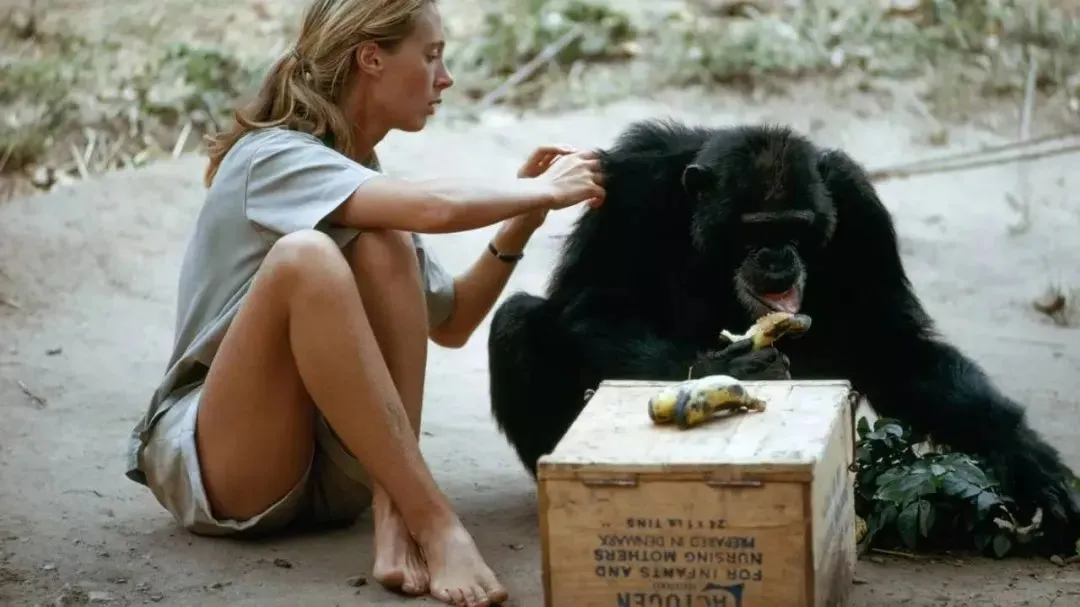
纪录片《珍》剧照。
1960年,古道尔的发现引发了学界的轰动。利基甚至发来一封电报,写道:“现在我们必须重新定义人类,重新定义工具,或者接受黑猩猩是人类的一部分!”
In fact, that was exactly one of the reasons Goodall was chosen by Louis Leakey, one of the world’s leading anthropologists at the time, to study chimpanzees in the wild. Leakey, who wanted someone with a mind unbiased by existing theories, also found in Goodall a passion for knowledge, a love of animals and monumental patience — the things that are still with her today.
Back in 1960, Goodall’s discovery was met with Leakey sending a telegram to her. “Now we must redefine man, redefine tool, or accept chimpanzees as humans!”
作为人类学家,利基派古道尔研究猩猩是为了深入了解人类石器时代的祖先们,而对于古道尔来说,与这些动物的互动,尤其是与一只名叫弗洛(Flo)的母黑猩猩及其孩子们的相处,对她的成长“意义重大”。
“弗洛具备一切一只母黑猩猩应有的特质——她对子女一往情深,她与他们玩耍,对他们极尽支持。这也是我的母亲对待我的态度——她生前一直不遗余力地支持我。”古道尔说道。她的母亲玛格丽特·迈凡薇·约瑟夫(Margaret Myfanwe Joseph, 1906-2000)是一位作家,一直以笔名瓦妮·莫里斯-古道尔(Vanne Morris-Goodall)发表作品。从古道尔个人的文字来看,她的母亲很显然将写作的天赋遗传给了她。
While Leakey’s goal was to gain a deeper understanding of his Stone-Age ancestors, for Goodall, her involvement with the animals, especially a female chimpanzee she named Flo and her children, “were very important to my own development” to quote Goodall.
“She was all things that a chimp mother should be — affectionate, playful, and supportive. That’s what my mother was — she supported me,” said Goodall, who was accompanied for the Gombe research by her mother Margaret Myfanwe Joseph (1906-2000), who wrote under the name Vanne Morris-Goodall and passed her writer’s genes to her daughter.
1967年3月4日,在与荷兰贵族兼野生动物摄影师雨果·范·劳维克(Hugo van Lawick)喜结连理三年后,古道尔成为了一名母亲。两人的缘分始于1962年,那年9月,《国家地理》委派劳维克前往冈比拍摄记录古道尔的研究工作。
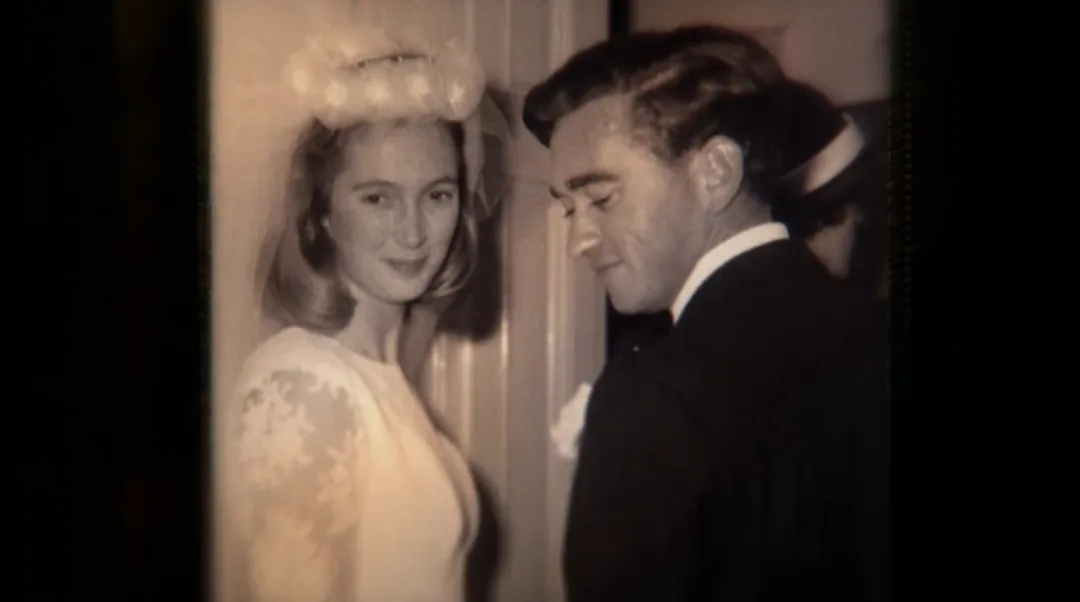
纪录片《珍》截图
起初古道尔对《国家地理》的这个决定并不十分欢迎,她已经习惯了独处。然而她很快就发现,劳维克除了烟瘾很大以外,还是一个对待工作的完美主义者,是一个与她一样从小就热爱动物的人。在劳维克的镜头下,古道尔展现出活泼调皮的一面, 譬如伸出舌头做个鬼脸。
两人相处几个月后,劳维克结束工作离开了冈比。他走后发给古道尔的第一封电报是:“你愿意嫁给我吗?”“我愿意!”古道尔答复说
Goodall herself became a mother on March 4, 1967, having married three years earlier. Her husband Hugo van Lawick, a Dutch nobleman and wildlife photographer, was sent in September 1962 by National Geographic to film Goodall in Gombe.
Initially, Goodall was not particularly enthusiastic about the decision, harboring doubts about the idea of "someone entering my little paradise." She later discovered that her co-worker was a chain smoker and a perfectionist that “drove me nuts”.
After Lawick left Gombe at the end of his work in early 1964, he sent Goodall a telegram. “Would you marry me?” he asked. “Yes,” was Goodall’s answer.
古道尔给他们的儿子起的小名是 “虫虫”(Grub),这显然和她对大自然的热爱是密不可分的。古道尔回忆说,成为母亲后,她才真正理解“当有人靠近幼崽时,母黑猩猩愤怒挥舞手臂发出威胁时的那种情绪”。
然而,让母猩猩感到愤怒的人里并不包括古道尔。1967年,当弗洛生下儿子弗林特(Flint)时,古道尔已经是这个黑猩猩社区的非正式成员了。在劳维克的镜头下,古道尔与幼年弗林特玩耍,用一只玩具黑猩猩试图吸引他的注意。古道尔孩童时期,她的父亲曾经送给她的一只毛绒玩具黑猩猩。在很长一段时间里,她对这只玩具猩猩珍爱异常。
Goodall nicknamed her son Grub, out of her love of nature. According to her, only after becoming a mother herself did she understand why “a chimpanzee mother furiously waved her arms and barked out threats to anyone who approached her infant too closely”.
Yet that “anyone” didn’t include Goodall. By the time Flo gave birth to her son Flint in 1964, around the time of Goodall’s marriage, she had long been an unofficial member of the chimpanzee community. Under Lawick’s camera, Goodall played with Flint the toddler, trying to attract his attention with a stuffed toy chimpanzee. In fact, it was a toy chimpanzee given to Goodall by her father that first triggered her interest in the animals.

20世纪60年代,珍·古道尔与还是婴儿的黑猩猩弗林特(弗洛的儿子)在坦桑尼亚冈比国家公园,图片由JGI/雨果·范·劳维克提供
童年的古道尔就显示出对动物的强烈兴趣。正因如此,当一位同学邀请她前往对方在肯尼亚的家族农场时,古道尔兴奋地答应了。在那里,古道尔见到了利基,并向这位人类学家展示出了自己作为研究者的潜力。
20世纪60年代,古道尔对黑猩猩能够制造简单工作并且拥有复杂感情的观察挑战了人类独特性的传统观念,在西方社会引发了强烈的反响。一些人试图以她年轻女性的身份贬低她的研究的学术价值。尽管如此,古道尔的名声还是不断攀升。
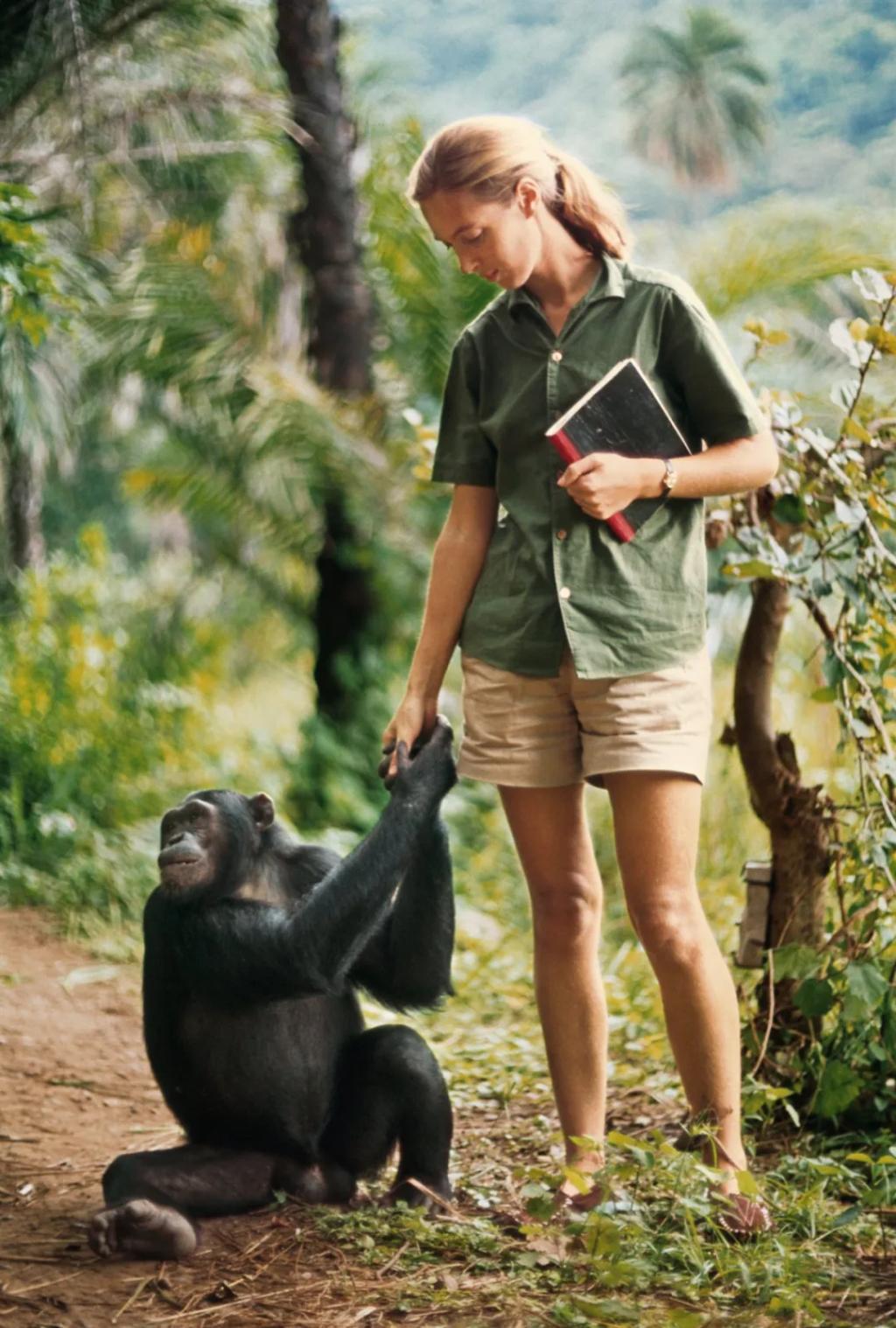
纪录片《珍》剧照。
“我成为了《国家地理》的封面女郎,有人说我的名气来自我颀长的双腿……当时我已经需要通过自己筹款来继续我在冈比的研究,于是我利用了这鹊起的声名。”古道尔在2017年的纪录片中坦言。
纪录片中大量镜头展示了20世纪60年代的古道尔——她身穿标志性的卡其色衬衫和短裤,穿梭于冈比保护区的丛林中。这些由劳维克拍摄的影像资料长期存于《国家地理》的档案中,2014年才被重新发现。而此时距离劳维克去世已经12年了。(古道尔与劳维克因为工作原因聚少离多,两人于1974年离婚但一直保持着好友的关系,直到劳维克于2002年离世。)
That childhood interest, kept alive by Goodall, led the young English woman to accept a schoolmate’s invitation to the latter’s family farm in Kenya, where Goodall met Leakey and proved her worth to the anthropologist.
In the 1960s, Goodall’s observation, which challenged human uniqueness, was met with “a violent uproar” to use her words. Some sought to discredit her on the grounds of Goodall being a young woman. “Comely Miss Spends Her Times Eyeing Apes” was the headline carried by one newspaper.
But Goodall’s fame continued to grow. “I was the Geographic cover girl and people said my fame was due to my legs. ... By this time I need to raise money myself, so I made use of it,” said Goodall in the 2017 documentary, which shows her roaming the Gombe reserve in the 1960s wearing her now-iconic Khaki shirts and shorts. The man behind the video camera was Lawick, whose 100 hours of previously unseen Goodall footage was only discovered in National Geographic’s archive in 2014, twelve years after his passing in 2002. (The two divorced in 1974 after being separated for extended periods due to their work commitments but remained close friends until Lawick's passing.)
1977年,古道尔创立了“珍·古道尔研究会”(Jane Goodall Institute, JGI),以推动冈比的研究项目。她同时还在非洲和其他地区推动多个以社区为中心的保护与发展项目,其中就包括旨在激励年轻人的“根与芽”(Roots & Shoots)项目。
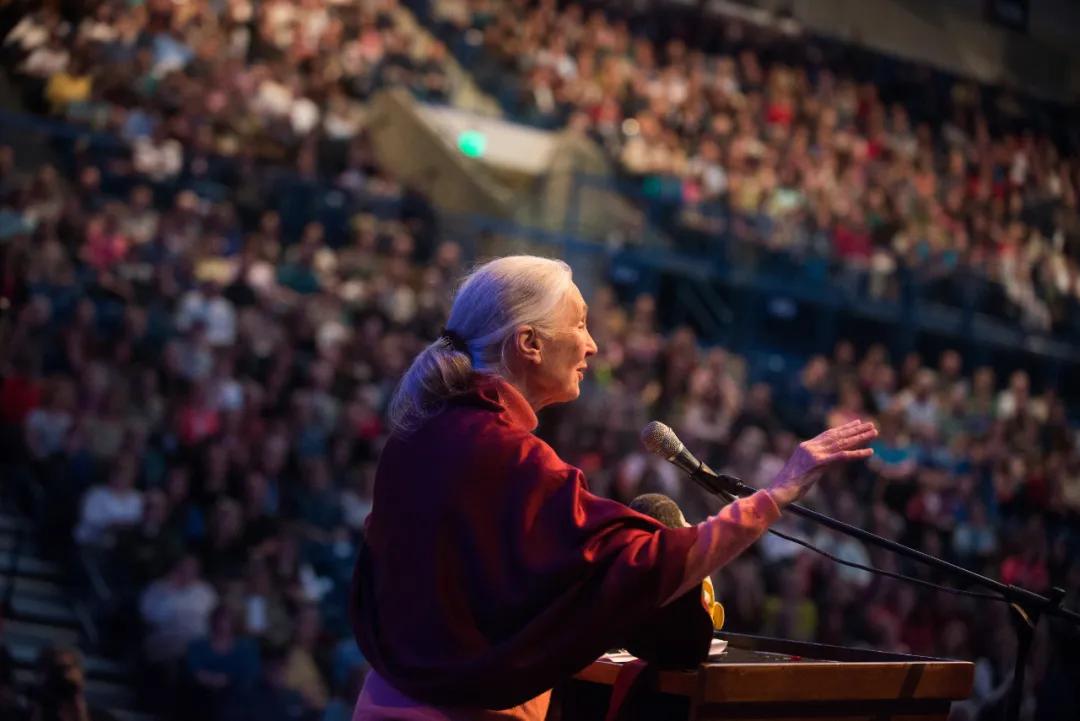
珍·古道尔博士在美国华盛顿州斯波坎市的贡扎加大学发表演讲,图片由拉贾·罗斯/贡扎加大学提供
在过去几十年里,冈比国家公园的研究所为许多女科学家提供了科研环境,这在古道尔刚刚开启她的研究的时候是不可想象的。那个时候,“灵长学类”是一个完全由男性统治的学科。除了通过JGI发起项目支持女性科学家,古道尔还为年轻非洲女孩提供生殖健康教育,并通过奖学金资助她们中的部分人完成大学学业。
当年完成高中教育的古道尔,因为家庭经济条件所限无法入读大学。在她的恩师利基的帮助下,古道尔于1962年进入英国剑桥大学学习并于1966年获得博士学位,她也因此成为第八位在未持有学士学位的情况下被获准攻读博士学位的人。
In 1977, Goodall established the Jane Goodall Institute (JGI) to support the Gombe research, and to spearhead multiple community-centered conservation and development programs in Africa and elsewhere. Among these programs is Roots and Shoots, which allows young people to take the initiative in environmental protection.
Acutely aware of the social constraints faced by women, Goodall’s research center at Gombe today hosts many woman scientists, who were nearly absent from the field when Goodall began. Goodall also launched projects under JGI to support young African girls by offering them access to reproductive health education and through scholarships to finance their college tuition.
Goodall herself, unable to initially go to college due to financial constraints, gained her PhD at Cambridge in 1966, the eighth person to be allowed to study for a PhD at Cambridge without first having obtained a bachelor’s degree.
从20世纪80年代中期开始,目睹自然环境的持续恶化后,古道尔将自己的精力投入到环境保护的倡导工作中。如今已年届90岁的她,依然每年有约300天奔波于世界各地,为环保事业不懈努力。
Horrified by the natural degradation she saw all around her, Goodall has devoted herself to advocacy since the mid-1980s. Having celebrated her 90th birthday this April, she continues to travel approximately 300 days a year over the past few years.
在20世纪70年代,古道尔经历了一段“非常黑暗的时期”。当时,她目睹了两个黑猩猩群体之间持续数年的激烈冲突。这两个群体原本属于同一个黑猩猩社区,弗洛和她的孩子也属于这个社群。
“我不得不接受,人类黑暗与邪恶一面深深扎根于我们的基因中,是我们古老的灵长类祖先遗传下来的部分。”古道尔感叹道。
Back in the 1970s, Goodall experienced “a very dark time” as she witnessed the prolonged brutal conflict between two rivaling groups of chimpanzees who used to belong to one big chimpanzee community that included Flo and her children.
“I’d come to accept that the dark and evil side of human nature was deeply embedded in our genes, inherited from our ancient primate ancestors,” lamented Goodall.
这场冲突被古道尔称为“四年战争” (Four Year War)。战争始于1974年,也就弗洛去世两年后,而弗洛生前是这个社群占有主导地位的雌性成员。
“弗洛是在横渡一条水流清澈的小溪的时候倒下的。她看起来是如此平静, 就好像她的心跳是在一瞬间突然停止的一样。”古道尔回忆道。“弗林特坐在岸边,他不时走近母亲的尸体,似乎在乞求她像平时一样梳理他、安慰他。”
The “Four Year War”, as Goodall calls it, erupted two years after the death of Flo, a dominant female member of her community and the beloved mother of Flint.
“Flo died as she crossed a clear, fast, flowing stream. She looked so peaceful — it was as if her heart had suddenly just stopped beating. Flint sat on the bank of the stream near Flo’s body. From time to time he approached her as though begging her to groom him, to comfort him as she had always done throughout his life,” said Goodall.
弗洛去世仅三周后,弗林特也离开了这个世界。
分析弗林特对母亲情感上的过度依赖时,古道尔说:“在弗林特只有4岁半的时候,他的小妹妹出生了,正常情况下,母猩猩都会在前一位子女年龄更大的时候才会诞下新的生命。所以,弗林特对妹妹的出生感到非常不安。然而他的妹妹不久后死掉了,于是他的母亲重新接纳他并且把他当成婴儿照顾。她让他再次骑在她背上;他试图吃奶,但她已经没有乳汁了;她晚上也和他一起睡觉。这是一个非常特殊的情况,我认为这就是弗林特对母亲产生了非同寻常的情感依赖,并且在弗洛去世后无法生存下去的原因。”
Three weeks after Flo died, Flint died too.
“Flint was only, I think it was 4.5 when his little sister was born. That's actually younger than normal. So he was particularly upset at the birth of his sister. And then the reason that he died after the death of his mother was because when his little sister died, his mother accepted him back as an infant. She let him ride on her back again. He tried to suckle, but she didn't have any milk. And she slept with him at night,” said Goodall. “So that was a very unusual situation that I think is why he died at the loss of his mother.”
古道尔在刚果共和国的特希雷岛建立的钦潘加黑猩猩康复中心(Tchimpounga Chimpanzee Rehabilitation Center) 是非洲最大的黑猩猩康复中心之一。这个康复中心主要收容因非法猎杀而失去家人保护的幼年黑猩猩。在珍·古道尔研究会官网上公开的一段视频中,一只名为旺而达(Wounda)的雌性黑猩猩在被放归野外前,用一个无比温柔和长久拥抱表达了对古道尔的感激。
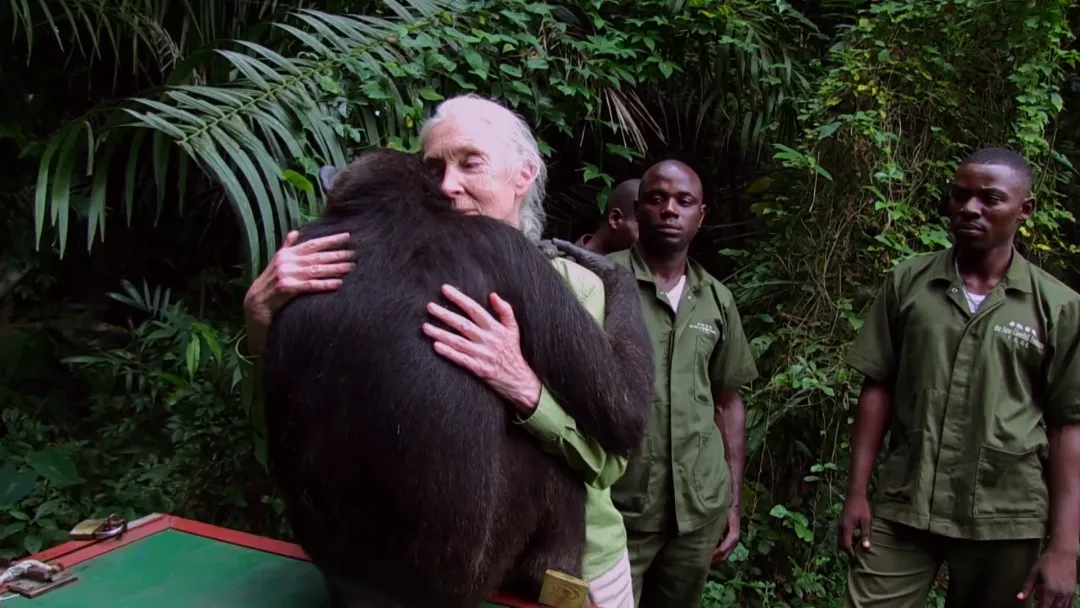
“这个拥抱的温度令我永生难忘。”古道尔说。
At the chimpanzee rehabilitation center founded by Goodall in Pointe Noire, Republic of Congo, chimpanzees orphaned by the bushmeat trade are nurtured with love and care before being released. In a video on JGI's website, a female chimpanzee named Wounda, who was rescued as a baby and grew up at the center, enveloped Goodall in a gentle hug before heading into the wild.
"The warmth of her embrace is something I shall never forget," said Goodall.